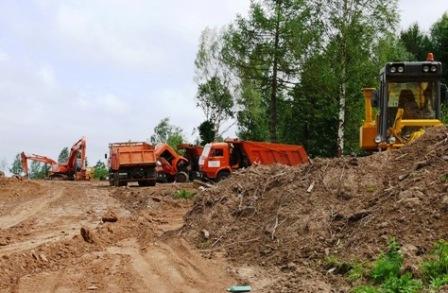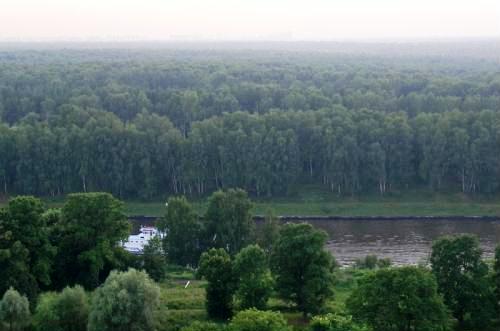 The Khimki Forest Park.Photo: oDRussia[JULY 21 UPDATE] Some time during the third week of July, workers for the French construction company Vinci began cutting trees along the route of the proposed road. They were discovered by activists and when they could not produce a cutting permit, a fight broke out and the workers chased off. Activists have now set up a tent camp in the new forest clearing and have kept the company’s saws and bulldozers at bay. However, a manager of the cutting crew drove into the camp late at night and assaulted the leader of the activists, Evgenia Chirikova (quoted below). The road project still lacks funding and permits, so the cutting is seen as an illegal act of intimidation. See news story here for more info and images.
The Khimki Forest Park.Photo: oDRussia[JULY 21 UPDATE] Some time during the third week of July, workers for the French construction company Vinci began cutting trees along the route of the proposed road. They were discovered by activists and when they could not produce a cutting permit, a fight broke out and the workers chased off. Activists have now set up a tent camp in the new forest clearing and have kept the company’s saws and bulldozers at bay. However, a manager of the cutting crew drove into the camp late at night and assaulted the leader of the activists, Evgenia Chirikova (quoted below). The road project still lacks funding and permits, so the cutting is seen as an illegal act of intimidation. See news story here for more info and images.
—
Three Aprils ago, in early 2007, a Russian regional governor announced plans to construct a new road connecting Moscow and Saint Petersburg. Though everyone agreed on the need for the road, no one in the north Moscow suburb of Khimki could understand why part of it needed to be routed through their beloved Khimki Forest Park.
Khimki is a Moscow suburb that suffers major pollution from heavy industry and cramped highways, so this massive park (2,470 acres) is an oasis widely enjoyed by residents who walk paths by glades of 100 year old oaks, collect drinking water from a natural spring, and watch abundant wildlife including elk, boar, birds, and at least one critter on the Red List of endangered species, the peat copper butterfly. There is also a cranberry bog and the forest is widely believed to contain an undiscovered mass grave of Stalin-era dissidents.
The cultural, historic, and ecological importance of Khimki Forest Park is clear, then, yet the proposed road would connect Moscow to Sheremetyevo airport north of town, cutting the forest into two small and sickly halves. The road would itself be somewhere between 400 and 600 meters wide plus it would also take substantial land on each side for capital construction and transportation infrastructure, requiring extensive logging and nearly total development.
Beside the sad and shocking ecological and cultural loss, additional controversy stems from the fact that Russian law forbids conversion of parks to uses like roads or industry. This law alone would have ultimately been sufficient to block the project, but it was lifted in early 2009 by an amendment to federal legislation. But there was other hope for Khimki residents: a separate law forbids a change of use for public forestland if alternative sites or routes can be found. Since the Transport Minister disclosed unwittingly in 2008 the existence of such alternative routes, the government was clearly acting illegally.
So why was this happening, people wanted to know, when there are other options? And why did the mayor of Khimki choose the most destructive of the three options for putting the road through the forest? These questions were not answered satisfactorily by local or federal officials, and in the vacuum a lot of well-founded speculation on political corruption and enormous profit has festered.
The construction industry is believed to be the most profitable one in Russia, even more than oil, but has suffered like everywhere else during the global recession. Yet major capital projects are recession-proof and among the most profitable construction projects normally undertaken (in part due to the rarity of open land easily converted to new use and also the value of the timber that can be extracted). In addition to the huge profits in highway construction (new roads in Russia cost $237 million per kilometer compared with $6 million per km in the U.S., according to a watchdog group), it is almost certain that commercial and residential building would be another lucrative activity sanctioned within most of the current boundaries of the forest.
Taking a broader view, though, similar proposals that would convert conservation lands for profit exist in 26 different locations in the country, and adding the fact that the construction industry has a very direct relationship with the government officials that regulate it, it starts to bring an overall plan for bailing out a suffering industry (dominated by a few very wealthy firms) into focus.
The editor of Khimki-area newspaper Khimkinskaya Pravda Mikhail Beketov editorialized freely on these issues as they related to the Khimki Forest project until he was brutally attacked in 2008. As he lay in a coma, his baseball bat-wielding assailant even phoned the hospital and threatened to finish him off. Beketov was looking into the mayor’s financial holdings for evidence of graft, but he’ll never finish that in his current poor state of health, another example of why Russia is rated as one of the most dangerous countries in the world to be a journalist.
 Defense of Khimki Forest protest.Photo: ECMO.ruThe grassroots response to the Khimki road proposal centers on the group Defense of Khimki Forest (Ekooborona, in Russian), which got started with a rally in front of the Park in early June 2007 to raise awareness in advance of a public meeting a few days later that hundreds of people attended. What followed has been an extremely fierce grassroots campaign including mass protests, a petition addressed to the Russian President (totaling over 20,000 signatures to date), letter writing to government officials, and public rock concerts that raise awareness and generate many more signatures. Their campaign has received coverage in major papers like Izvestia and on television, in Russia and abroad.
Defense of Khimki Forest protest.Photo: ECMO.ruThe grassroots response to the Khimki road proposal centers on the group Defense of Khimki Forest (Ekooborona, in Russian), which got started with a rally in front of the Park in early June 2007 to raise awareness in advance of a public meeting a few days later that hundreds of people attended. What followed has been an extremely fierce grassroots campaign including mass protests, a petition addressed to the Russian President (totaling over 20,000 signatures to date), letter writing to government officials, and public rock concerts that raise awareness and generate many more signatures. Their campaign has received coverage in major papers like Izvestia and on television, in Russia and abroad.
Court challenges to the legality of the proposal have all failed, though, and a corresponding lack of substantive response from elected officials to grassroots pressure didn’t change the story, so ECMO did the next sensible thing and took aim at the foreign companies and banks providing the project with expertise and financing. Vinci, a French construction firm, saw a procession of activists symbolically pile ‘Khimki firewood’ outside the front doors of its Moscow office, for instance, and activists also began putting pressure on the main funder of the project, the European Bank for Reconstruction and Development (EBRD).
When Greenpeace and World Wildlife Fund began calling on all banks to avoid the project, watchdog groups like Bankwatch took notice as well as Greens in the European Parliament, who proposed a resolution warning investors away from Khimki. After that resolution passed, the EBRD halted its headlong rush into funding the road, pending a new series of reviews, which is a clear victory for the activists.
Reacting in the most flagrant of manners, Russian Prime Minister Vladimir Putin then signed an executive order in November 2009 that allowed a variance for the road to go through Khimki forest regardless of the law. Brave Ekooborona activists immediately filed suit and began publicly calling on President Medvedev to dismiss Putin.
In the most recent lawsuit in March of this year, Ekooborona argued that since official alternative routes for the road existed, this proved that the transfer of Khimki Forest lands to the status of ‘developable lands’ had been unlawful. Despite a lack of substantive argument by the defendants, the court dismissed the suit. The government’s own Commissioner for Human Rights intervened, questioning the legality of the project, but the appeal was rebuffed in April.
So the battle for Khimki Forest has been largely painful defeats and outright casualties for the last 3 years. Yet each loss shines light on a very dim proposal that can’t stand the light of day. The resulting new caution shown by EBRD has sent project proponents into a frenzy of doubt, as the capital expense is major and difficult to justify in the current economic climate.
 Russian road building is on the rise.Photo: oDRussiaNationwide, government-planned road building is on the rise, as most existing roads are either in bad shape or very bad shape, but plans that squander huge sums of money while harming the public good, as projects like the Moscow-St. Petersburg highway illustrate well, seem far from serving the national interest. The fact that the new roads are likely to come at the expense of Russia’s increasingly dear urban conservation lands seems intolerable and also inevitable without some serious grassroots victories.
Russian road building is on the rise.Photo: oDRussiaNationwide, government-planned road building is on the rise, as most existing roads are either in bad shape or very bad shape, but plans that squander huge sums of money while harming the public good, as projects like the Moscow-St. Petersburg highway illustrate well, seem far from serving the national interest. The fact that the new roads are likely to come at the expense of Russia’s increasingly dear urban conservation lands seems intolerable and also inevitable without some serious grassroots victories.
As Evgenia Chirikova, leader of Ekooborona, wrote recently, “It’s clear that the problem is not restricted to the Khimki forest alone. (Khimki) is only a testing ground for the fine-tuning of methods for the commercial development of conservation areas.”
Such development may be claimed to be for the public good, but unless citizens have input and are consulted properly, projects like this are unlikely to have popular support, and Russia’s ecological and cultural heritage may suffer.
To learn more, support the campaign for Khimki Forest, or sign the petition, visit this translation of Ekooborona’s website.



